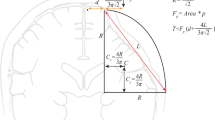Summary
Pressure of brain retraction was measured with a strain gauge spatula in 31 cases of 21 tumours and 10 aneurysms. They were operated on via different approaches: subfrontal (10 cases), interhemispheric (5), subtemporal (7) and suboccipital (9). The patients' age ranged from 11 to 74 years (average 50). The recorded data were averaged for every 5 minutes and divided into two groups: the first was data taken in the initial stage during the approach to the lesions, and the second were those taken during procedures at and around the lesion. Significant difference in the pressure among different approaches was found in the tumour group approached by the subtemporal route compared with other routes (p < 0.005). The retraction pressures in the tumour cases were higher during the approach (31±15.5 torr) than during the main procedure (12±9.2 torr) (p < 0.025). On the other hand, the pressures in the aneurysm cases were the reverse, being lower during the approach (22±15.2 torr) than during the main procedure (38±17.7 torr) (p < 0.01). Early-stage operations for aneurysm required a higher retraction pressure than delayed operations.
Similar content being viewed by others
References
Abe H, Tsuru M, Ito T, Kaneko S, Nakagawa Y, Iwasaki Y, Aida T, Kamiyama H, Echizenya K (1981) Temporal lobe damage as pitfalls at subtemporal transtentorial approach. No Shinkei Geka 9: 819–827
Albin MS, Bunegin L, Bennett MH, Dujovny M, Jannetta PJ (1977) Clinical and experimental brain retraction pressure monitoring. Acta Neurol Scand [Suppl 64] 56: 522–523
Albin MS, Bunegin L, Helsel P, Marlin A, Babinski M (1980) Intracranial pressure and regional cerebral blood flow responses to experimental brain retraction pressure. In: Shulman Ket al (eds) Intracranial pressure IV. Springer, Berlin Heidelberg New York, pp 131–135
Cabral R, King TT, Scott DF (1976) Incidence of postoperative epilepsy after a transtentorial approach to acoustic nerve tumours. J Neurol Neurosurg Psychiat 39: 663–665
Donaghy RMP, Numoto M, Wallman LJ, Flanagan ME (1972) Pressure measurement beneath retractors for protection of delicate tissues. Am J Surg 123: 429–431
Fujimoto S, Kuyama H, Nishimoto K, Akioka T, Nagao S, Nishimoto A (1982) Effect of local brain retraction on local cerebral blood flow and neural function. Experimental study. Neurol Med Chir (Tokyo) 22: 893–900
Hongo K, Kobayashi S, Yokoh A, Sugita K (1987) Monitoring retraction pressure on the brain. An experimental and clinical study. J Neurosurg 66: 270–275
Ishii S, Hayner R, Kelly WA, Evance JP (1959) Studies of cerebral swelling II. Experimental cerebral swelling produced by supratentorial extradural compression. J Neurosurg 16: 152–166
Jannetta PJ (1967) Arterial compression of the trigeminal nerve at the pons in patients with trigeminal neuralgia. J Neurosurg 26: 159–162
Jannetta PJ (1974) Complications from microsurgical treatment of tic Douloureux. J Neurosurg 40: 675
Miller JD, Stanek AE, Langfitt TW (1973) Cerebral blood flow regulation during experimental brain compression. J Neurosurg 39: 186–196
Numoto M, Donaghy RMP (1970) Effects of local pressure on cortical electrical activity and cortical vessels in the dog. J Neurosurg 33: 381–387
RosenØrn J, Diemer NH (1982) Reduction of regional cerebral blood flow during brain retraction pressure in the rat. J Neurosurg 56: 826–829
RosenØrn J, Diemer NH (1985) Intermittent versus continuous brain retractor pressure as protective procedure against ischaemic brain cell damage. In: Auer LM (ed) Timing of aneurysm surgery. Walter de Gruyter, Berlin New York, pp 381–383
RosenØrn J, Diemer NH (1985) The risk of cerebral damage during graded brain retractor pressure in the rat. J Neurosurg 60: 608–611
Sugita K, Hirota T, Mizutani T, Mutsuga N, Shibuya M, Tsugane R (1978) A newly designed multipurpose microneurosurgical head frame. J Neurosurg 48: 656–657
Sugita K, Kobayashi S, Shintani A, Mutsuga N (1979) Microneurosurgery for aneurysms of the basilar artery. J Neurosurg 51: 615–620
Sugita K, Kobayashi S, Yokoh A (1982) Preservation of large bridging veins during brain retraction. Technical note. J Neurosurg 57: 856–858
Yamaguchi M, Shirakata S, Yamasaki S, Matsumoto S (1976) Ischemic brain edema and compression brain edema. Water content, blood-brain barrier and circulation. Stroke 7: 77–83
Yokoh A, Sugita K, Kobayashi S (1983) Intermittent versus continuous brain retraction. An experimental study. J Neurosurg 58: 918–923
Author information
Authors and Affiliations
Additional information
Retractor with a strain gauge and amplifier manufactured by Tokai Rika Medical Electronics, Oguhi-cho, Aichi-ken 481-01, Japan.
Rights and permissions
About this article
Cite this article
Yokoh, A., Sugita, K. & Kobayashi, S. Clinical study of brain retraction in different approaches and diseases. Acta neurochir 87, 134–139 (1987). https://doi.org/10.1007/BF01476064
Issue Date:
DOI: https://doi.org/10.1007/BF01476064




